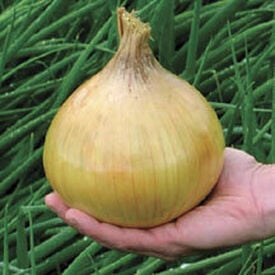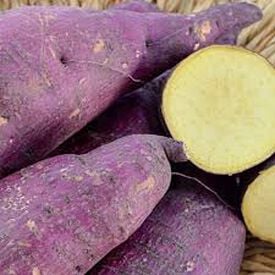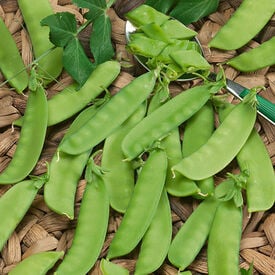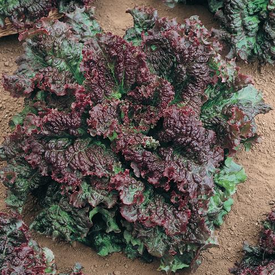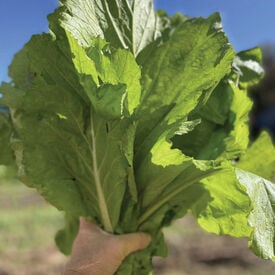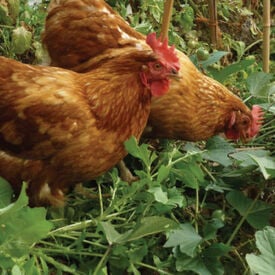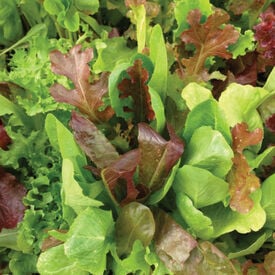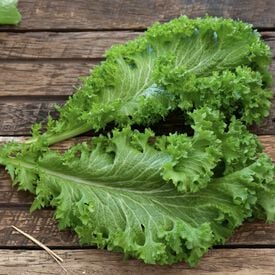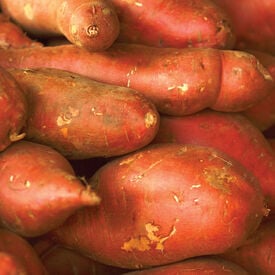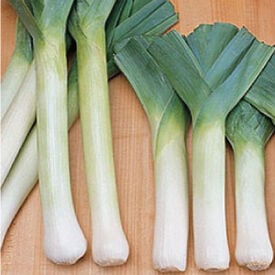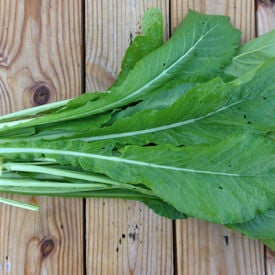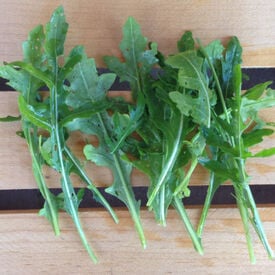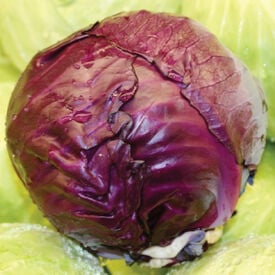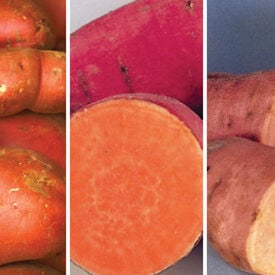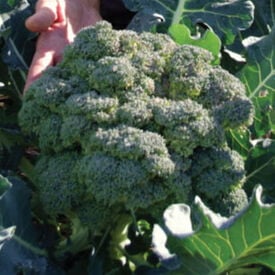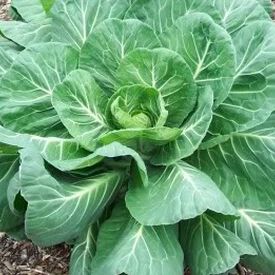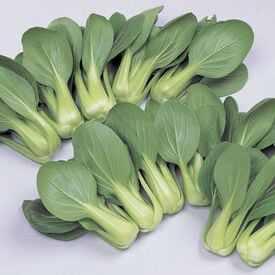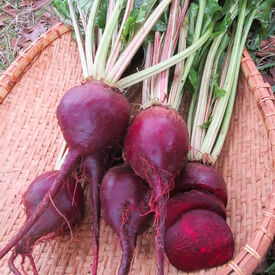Ailsa Craig Exhibition is a large onion that has a unique mildly sweet flavor! This plant produces on the average a huge 5 lb. sweet white onion that has a delicious flavor in many dishes. Impress your neighbors and try growing this World Record sized onion.
The Murasaki Purple Sweet Potato is a very delicious purple-skinned sweet potato with white flesh. This sweet potato variety is a Japanese sweet potato that offers very good yields and a delicious taste!
The Mammoth Melting Pea is a snow pea that adds the perfect mouthwatering crunch to any salad! The 5-6 foot tall vines require trellising for support. This variety's large sweet pods thrive in the cooler weather. Add a fresh pop of bright green to any garden or dish with the Mammoth Melting! Certified Organic. Learn more about our organic seeds.
The Gabriella is a loose leaf lettuce variety that has beautiful deep wine colored leaves. This variety's purple leaves are frilly and sweet -- perfect for adding a pop of color to salads! The Gabriella's leaves are delicious from mesclun size to maturity. This variety is heat resistant and slow bolting.
Florida Broadleaf mustard is a classic Southern heirloom variety long valued for its fast growth, large yields, and reliable performance in warm climates. Originating in the southeastern United States, it produces broad, bright green, smooth-edged leaves that can grow 10–12 inches long, forming an upright, leafy plant about 18–24 inches tall. The leaves are tender yet substantial, with a bold, peppery flavor that mellows pleasantly when cooked. This mustard variety thrives in full sun and prefers rich, well-drained soil with consistent moisture. It grows best in cool to mild temperatures, typically between 50–75°F, making it ideal for spring and fall gardens, though it can tolerate light frosts and brief periods of heat.
Growing your own forage for your chickens is a cheap, easy, and a highly nutritious way to feed your chickens. Chicken feed can be expensive to provide throughout the year. Growing your own from spring to fall provides high levels of nutrients that will make your eggs taste even better. Foraging chickens have a better balanced diet that creates better eggs and meat. This chicken forage blend is a mix of well balanced plants that chickens love to eat. Spread at 5 lbs. per 1,000-2,000 square feet. 100 lbs will cover 1 acre. Mixture includes: Annual Ryegrass, Perennial Ryegrass, Buckwheat, Flax, Millet, Forage Peas, Red Clover, Alfalfa
The Garden Leaf Blend is a colorful mix of our very popular lettuce varieties. This blend is a great mixture of lettuce varieties that mature at different times and have multiple colors to give your salad bowl a full pop of color! The Garden Leaf Blend includes Black Seeded Simpson, Oakleaf, Parris Island Cos, Tango, Red Romaine, Ruby and Lolla Rosso Darky
The Old Fashioned Mustard Green is a real Southern treat! This green is a favorite that can be eaten fresh or cooked, but is best enjoyed either steamed or sautéed in our opinion! The Old Fashioned Mustard is easy to grow and care for, making it a great addition to any garden.
Certified - Georgia Jets is such a fast growing sweet potato! This sweet potato is a marvelous variety that just like its name suggests, matures extremely fast! In 90 days you will have large, ready to eat sweet potatoes. Georgia Jets is also high yielding!
King Richard is a newer leek variety that grows well throughout the United States. This leek variety is a summer type, non-bulbing leek that grows to 12" in length. King Richard has green leaves with white inside. This leek is a very early maturer and is not sufficient for overwinter growing.
Tendergreen Spinach (Komatsuna) mustard is a prized leafy green known for its mild flavor and tender texture, making it a favorite in both culinary and gardening circles. This variety of mustard greens has its roots in traditional Southern U.S. agriculture, where it has been cultivated for its versatility and ease of growth. Characterized by its large, bright green leaves with a smooth, slightly wrinkled texture, Tendergreen mustard is valued for its mild, peppery flavor that becomes more pronounced when cooked. The plants grow rapidly, reaching maturity in about 40 to 50 days, and are known for their robust, upright growth habit, typically standing 12 to 18 inches tall. They produce small, yellow flowers in early spring if allowed to bolt, though they are primarily grown for their leaves. Tendergreen mustard thrives in cool weather and can be grown in a variety of soil types as long as they are well-drained. The plant’s resilience and quick harvest make it ideal for successive plantings, providing a continuous supply of fresh greens. With its rich flavor, adaptable growing conditions, and rapid growth, Tendergreen mustard is a valuable addition to any vegetable garden.
A slow growing arugula with great tasting peppery leaves! This variety produces 4" deeply cut leaves that have a slightly sharp pepper flavor. The Sylvetta is compact, heat and cold tolerant. If you are looking to spice up your salads and meals, then this is for you!
Red Express cabbage seeds produce a variety of cabbage known for its vibrant purple-red color and compact, round heads. This variety is prized for its early maturity, typically reaching harvestable size in about 60-70 days. The heads are tightly packed and dense, with crisp, tender leaves that offer a mild, sweet flavor, making it ideal for both fresh consumption in salads and slaws or for cooking. Red Express cabbage is also known for its resistance to common cabbage pests and diseases, making it a robust choice for home gardeners. Additionally, it provides a good source of vitamins A, C, and K, as well as antioxidants.
Enjoy a mouth watering blend of the Sweet Potato Mix! This mix contains all 3 of the sweet, delicious sweet potato varieties that we carry, the Georgia Jets, Beauregard and Centennial. Not sure which variety to buy? Try all 3!
The Fiesta is a beautiful, heavy yielding broccoli . Uniform plants are medium height, giving rise to 5-7" blue-green heads. Heavy yields that are disease resistant, which is definitely a reason to celebrate!
Georgia Southern is a large collard plant with a cabbage-like taste! This variety produces bluish-green leaves that can grow up to 36" tall and do not bunch or head like cabbage leaves. These large open heads are great for cooking or freezing. The Georgia Southern collard is vitamin rich, sweet, not bitter, heat tolerant, and frost hardy.
Li Ren Choi cabbage is good looking mini pak choi with light green stems and slightly darker green leaves. This variety develops a pak choi shape at a very early stage. It can even be planted in trays and harvested at transplanting time. It is one of the smaller mini pak choies on the market. Excellent production for pak choi hearts.
The Lutz Green Leaf White Stem Beet is an attractive deep red variety with white stalks that is absolutely delicious when steamed or roasted. This beet is known for having huge glossy, deep green tops that are perfect for salads! This beet is a "winterkeeper" beet that has a long standing storage capability. The Lutz Green Leaf White Stem has 6 inches in diameter roots.
